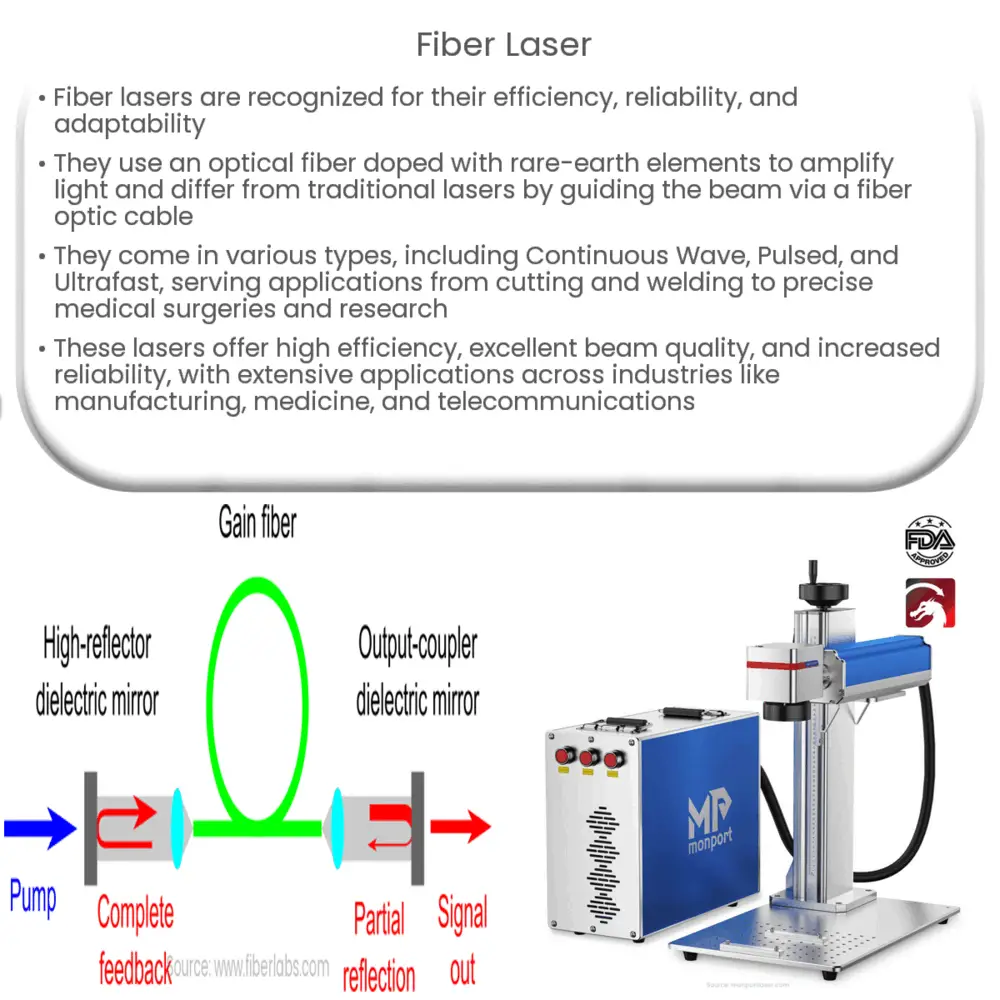Explore the world of Fiber Lasers – their operation, types, advantages, applications, and future trends in this comprehensive guide.

Understanding Fiber Lasers
The world of lasers is broad and diverse, with various types used in different applications, from medicine to manufacturing. Among these, Fiber Lasers are a unique category, recognized for their exceptional reliability, efficiency, and adaptability.
What is a Fiber Laser?
A fiber laser is a type of laser where the active gain medium is an optical fiber doped with rare-earth elements like erbium, ytterbium, neodymium, dysprosium, praseodymium, and thulium. This active fiber is designed to amplify light. The term ‘fiber’ refers to the light’s path, which, unlike in traditional lasers, is confined within a fiber optic cable.
The Basics of Fiber Laser Operation
In a fiber laser, the beam is generated by the rare-earth-doped fiber and is guided to the workpiece via the fiber optic cable. This differs from traditional lasers, where the beam is directed towards the workpiece using mirrors.
Types of Fiber Lasers
- Continuous Wave (CW) Fiber Lasers: These lasers emit a continuous laser beam, making them ideal for applications like cutting, welding, and drilling.
- Pulsed Fiber Lasers: These lasers emit pulses of light and are typically used in marking and engraving applications.
- Ultrafast Fiber Lasers: These lasers have incredibly short pulse durations (in the picosecond or femtosecond range). They’re used in highly precise applications like micro-machining, medical surgery, and research.
Advantages of Fiber Lasers
Fiber lasers offer several advantages over traditional lasers. Let’s explore some of these benefits:
- High Efficiency: The optical fibers used in fiber lasers have a higher surface area to volume ratio compared to the solid gain media used in traditional lasers. This allows for better cooling and higher efficiency.
- Reliability: Fiber lasers have fewer moving parts and no alignment issues, leading to higher reliability and lower maintenance needs.
- Beam Quality: The design of fiber lasers allows for high beam quality, resulting in precise and high-quality work.
Fiber Lasers in Industry
Fiber lasers have found widespread use in various industries, including manufacturing, medical, research, and telecommunications. In the manufacturing sector, they are employed for cutting, welding, and engraving due to their high precision and efficiency.
These lasers also have significant roles in the medical field, especially in surgery, where their high precision and controlled energy output are essential.
The telecommunications industry utilizes fiber lasers for signal amplification and data transmission over long distances, taking advantage of their high output power and beam quality.
Recent Developments and Future Trends in Fiber Laser Technology
As with any technology, the field of fiber lasers continues to evolve. Recent advancements have seen the introduction of higher-powered fiber lasers, with output powers reaching several kilowatts. This development has expanded the scope of applications, particularly in heavy industry sectors such as shipbuilding and automotive manufacturing.
Another significant development is the advent of single-mode fiber lasers, which provide an exceptionally high-quality beam. These lasers are particularly useful in precision applications, like microfabrication and high-resolution imaging.
Researchers are also exploring the potential of fiber lasers in areas like quantum computing and biophotonics. In quantum computing, the precise and high-quality beam of fiber lasers could potentially be used to manipulate qubits. In biophotonics, fiber lasers could enable advanced imaging techniques and therapeutic interventions.
Fiber Laser Safety
Like all lasers, fiber lasers need to be handled with care. Even though they are enclosed within a fiber, they can still cause harm if not used correctly. It’s essential to use appropriate safety measures, such as wearing laser safety glasses and following standard operating procedures.
Conclusion
In conclusion, fiber lasers represent a significant advance in laser technology, providing numerous benefits over traditional lasers, including high efficiency, excellent beam quality, and increased reliability. They have found applications across various sectors, from manufacturing to medicine and telecommunications.
As technology advances, so too does the field of fiber lasers, with recent developments offering even greater power and precision. The future of fiber lasers is undoubtedly exciting, with potential applications in emerging fields like quantum computing and biophotonics. However, as their use increases, it’s vital to remember the importance of safety in their operation. The promise of fiber lasers is extensive and, with ongoing research and development, we can anticipate further innovative applications and improvements in this transformative technology.

